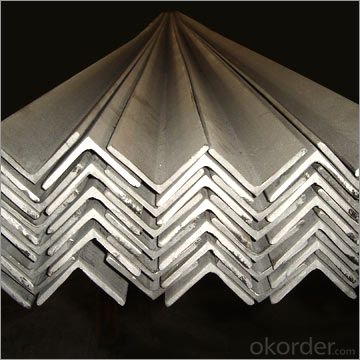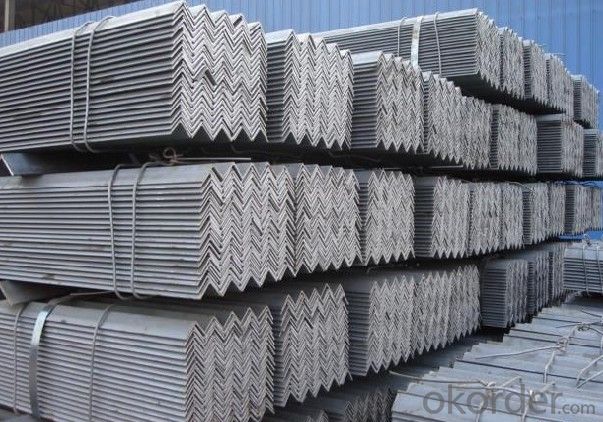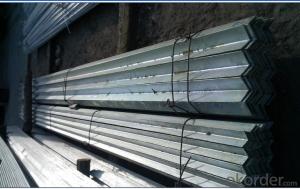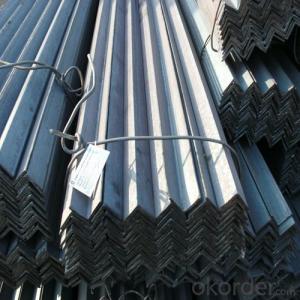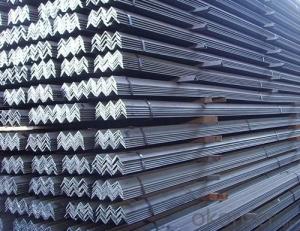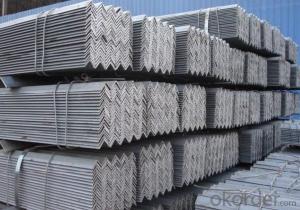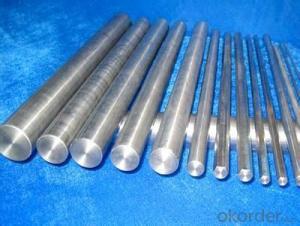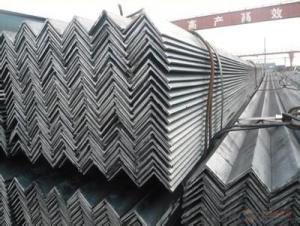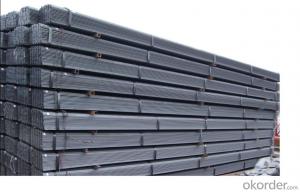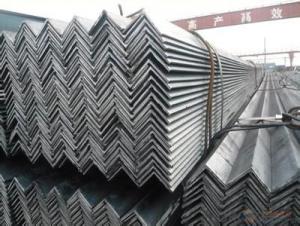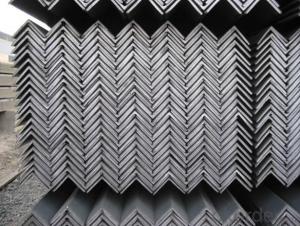Hot Rolled Steel Angel ASTM Or GB Q235 Or Q345
- Loading Port:
- Tianjin
- Payment Terms:
- TT OR LC
- Min Order Qty:
- 25 m.t.
- Supply Capability:
- 2000000 m.t./month
OKorder Service Pledge
OKorder Financial Service
You Might Also Like
Specification
Product Description:
OKorder is offering high quality Hot Rolled Steel Angel ASTM Or GB Q235 Or Q345 at great prices with worldwide shipping. Our supplier is a world-class manufacturer of steel, with our products utilized the world over. OKorder annually supplies products to European, North American and Asian markets. We provide quotations within 24 hours of receiving an inquiry and guarantee competitive prices.
Product Applications:
According to the needs of different structures, Angle can compose to different force support component, and also can be the connections between components. It is widely used in various building structures and engineering structures such as roof beams, bridges, transmission towers, hoisting machinery and transport machinery, ships, industrial furnaces, reaction tower, container frame and warehouse etc
Product Advantages:
Hot Rolled Steel Angel ASTM Or GB Q235 Or Q345 are durable, strong, and resist corrosion.
Main Product Features:
· Premium quality
· Prompt delivery & seaworthy packing (30 days after receiving deposit)
· Corrosion resistance
· Can be recycled and reused
· Mill test certification
· Professional Service
· Competitive pricing
Product Specifications:
Manufacture: Hot rolled
Grade: Q195 – 235
Certificates: ISO, SGS, BV, CIQ
Length: 6m – 12m, as per customer request
Packaging: Export packing, nude packing, bundled
Sizes: 25mm-250mm | ||||||||||||
a*t | ||||||||||||
25*2.5-4.0 | 70*6.0-9.0 | 130*9.0-15 | ||||||||||
30*2.5-6.6 | 75*6.0-9.0 | 140*10-14 | ||||||||||
36*3.0-5.0 | 80*5.0-10 | 150*10-20 | ||||||||||
38*2.3-6.0 | 90*7.0-10 | 160*10-16 | ||||||||||
40*3.0-5.0 | 100*6.0-12 | 175*12-15 | ||||||||||
45*4.0-6.0 | 110*8.0-10 | 180*12-18 | ||||||||||
50*4.0-6.0 | 120*6.0-15 | 200*14-25 | ||||||||||
60*4.0-8.0 | 125*8.0-14 | 250*25 | ||||||||||
FAQ:
Q1: Why buy Materials & Equipment from OKorder.com?
A1: All products offered byOKorder.com are carefully selected from China's most reliable manufacturing enterprises. Through its ISO certifications, OKorder.com adheres to the highest standards and a commitment to supply chain safety and customer satisfaction.
Q2: How do we guarantee the quality of our products?
A2: We have established an advanced quality management system which conducts strict quality tests at every step, from raw materials to the final product. At the same time, we provide extensive follow-up service assurances as required.
Q3: How soon can we receive the product after purchase?
A3: Within three days of placing an order, we will begin production. The specific shipping date is dependent upon international and government factors, but is typically 7 to 10 workdays.
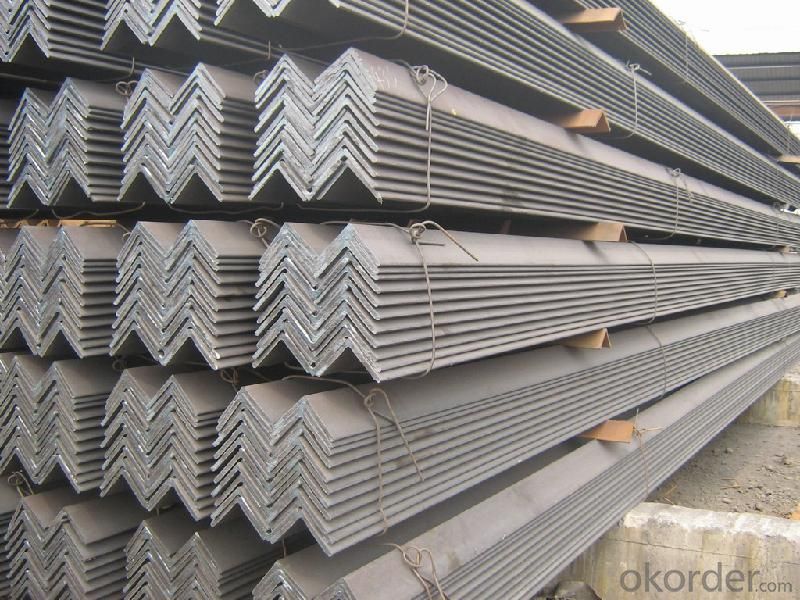
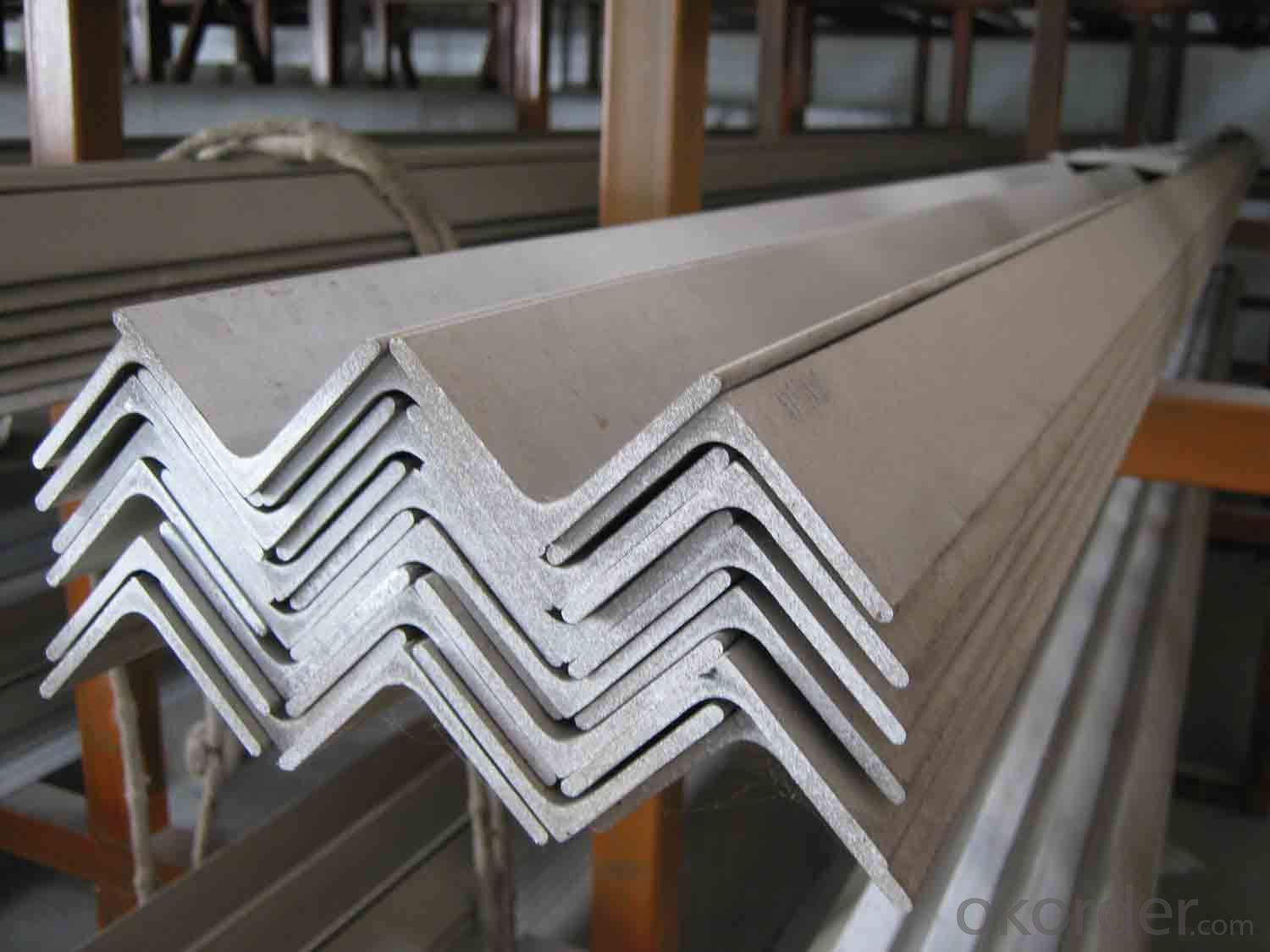
- Q: Bearing capacity of angle steel and channel steel
- Channel steel is a strip of steel with a cross section. Section steel with groove shape.Channel steel is a kind of carbon structural steel used for construction and machinery. It is a complex section steel. Its cross section has a groove shape. Channel steel is mainly used in building structure, curtain wall engineering, mechanical equipment and vehicle manufacturing, etc.. In use, it requires better welding, riveting performance and comprehensive mechanical properties. The raw material steel billet for channel steel is carbon or low alloy steel billets with a carbon content of not more than 0.25%. The finished channel steel is delivered by hot forming, normalizing or hot rolling. The specifications are expressed in millimeters of height (H) * leg width (b) * waist thickness (d), such as 100*48*5.3, which means waist height is 100 mm, leg width is 48 mm, waist thickness is 5.3 mm channel, or 10# channel steel. The same height of the channel, if there are several different leg width and waist thickness, also need to add a, B, C on the right side of the model to distinguish, such as 25#a, 25#b, 25#c and so on.Channel steel is divided into ordinary channel steel and light channel steel. Standard Specification for hot-rolled plain channel steel is 5-40#. Specifications for hot rolled flexible channel steel supplied by supply and demand agreement are 6.5-30#. Channel steel is mainly used for building structures, vehicle manufacturing, other industrial structures and fixed plates, cabinets, etc., and channel steel is often used in conjunction with i-beam.
- Q: Can steel angles be used as lintels?
- Yes, steel angles can be used as lintels. Steel angles are commonly used in construction as lintels due to their strength and durability. Lintels are structural elements that support the weight of the wall above an opening, such as a door or window. Steel angles are especially suitable for this purpose because they can bear heavy loads and provide excellent structural support. They are often used in masonry construction to create a strong and stable lintel. Additionally, steel angles can be easily customized to fit specific dimensions, making them a flexible choice for lintel applications.
- Q: What is the typical yield stress of steel angles?
- The yield stress of steel angles can differ based on the grade and type of steel utilized. Nevertheless, for frequently employed carbon steels, the yield stress typically varies between 36,000 and 50,000 psi. This indicates that the steel angles can endure a specific level of stress or pressure prior to experiencing deformation or permanent alteration in shape. It is crucial to acknowledge that distinct steel alloys and treatments can lead to different yield stresses. Therefore, it is essential to refer to the specific specifications or reference materials pertaining to the particular steel angle in question.
- Q: How do you determine the plastic section modulus of a steel angle?
- To determine the plastic section modulus of a steel angle, you need to follow a specific calculation process. The plastic section modulus (Z) is a measure of the ability of a cross-section to resist plastic bending. It is commonly used in structural engineering to analyze the strength and stability of members. To calculate the plastic section modulus of a steel angle, you need to know the dimensions of the angle cross-section, including the length of the legs and the thickness of the steel. Once you have these measurements, you can follow the steps below: 1. Identify the centroid of the angle cross-section: The centroid is the geometric center of the shape and is an important reference point for calculating the plastic section modulus. You can determine the centroid by finding the average of the coordinates of the vertices. 2. Calculate the moment of inertia (I): The moment of inertia is a measure of how the area is distributed around the centroid. It can be found by summing the individual moments of inertia for each component of the cross-section. For a steel angle, the moment of inertia can be calculated using standard formulas or tables. 3. Determine the plastic section modulus (Z): The plastic section modulus is directly related to the moment of inertia. It can be calculated by dividing the moment of inertia (I) by the distance from the centroid to the outermost fiber of the section. This distance is known as the distance to the extreme fiber (c) and is usually equal to half the thickness of the angle. The formula to calculate the plastic section modulus (Z) is Z = I / c. 4. Substitute the values: Once you have determined the moment of inertia (I) and the distance to the extreme fiber (c), plug these values into the formula to calculate the plastic section modulus (Z). By following these steps, you can determine the plastic section modulus of a steel angle. The plastic section modulus is a critical parameter in assessing the structural behavior and design of steel angles, especially when subjected to bending loads.
- Q: How do steel angles differ from other structural shapes?
- Steel angles possess several distinguishing characteristics that set them apart from other structural shapes. Firstly, their cross-section takes on a distinct L-shape, featuring two perpendicular flanges and a central web connecting them. This exceptional shape grants the angle exceptional strength and load-bearing capacity, rendering it suitable for a myriad of structural applications. Secondly, steel angles exhibit remarkable versatility, finding utility in a wide array of construction projects. They can be effortlessly welded, bolted, or screwed together to forge intricate structures like frames, supports, and bracings. This adaptability endows them with a favored status among engineers and architects. Furthermore, steel angles come in various sizes and thicknesses, allowing for customization tailored to precise project requirements. This assortment in dimensions streamlines the attainment of desired strength and stability in structural designs. Moreover, steel angles provide cost-effective solutions in comparison to alternative structural shapes. Their resourceful utilization of materials and manufacturing processes renders them relatively affordable, all while maintaining their durability and functionality. Lastly, steel angles exhibit an impressive capacity to withstand substantial loads and stresses, making them an idyllic choice for applications where structural integrity is of paramount importance. Their ability to evenly distribute weight across the flanges and web ensures stability and prevents deformation under heavy loads. In conclusion, steel angles epitomize unique structural shapes, endowing construction projects with strength, versatility, customizability, cost-effectiveness, and durability. These attributes distinguish them from other structural shapes, rendering them an excellent choice for diverse construction endeavors.
- Q: How do steel angles resist bending or deflection?
- Steel angles are able to resist bending or deflection because of their shape and material properties. The L-shaped cross-section of steel angles contributes to their structural stability and strength, resulting in a high resistance to bending or deflection under load. The L-shape of steel angles creates two legs that are perpendicular to each other. This design allows for a more efficient distribution of the applied load compared to other shapes. As a result, the angles are able to resist bending forces, preventing significant deformation or deflection. The longer leg of the angle provides greater leverage and stiffness, further enhancing its resistance to bending. In addition to the shape, steel itself is a strong and rigid material known for its high tensile and compressive strength. Steel angles are typically made from hot-rolled steel, which undergoes a process that improves its structural properties. The combination of the L-shape design and the inherent strength of steel enables steel angles to withstand bending forces without significant deflection. Furthermore, steel angles can be reinforced through methods such as welding or bolting to increase their resistance to bending or deflection. These reinforcements add extra strength and stiffness to the angles, making them even more robust and capable of handling higher loads. To summarize, steel angles resist bending or deflection due to their L-shape design, the inherent strength of steel, and possible reinforcements. These factors work together to provide structural stability and prevent excessive deformation, making steel angles a reliable choice for various construction and engineering applications.
- Q: Can steel angles be used in oil and gas pipeline installations?
- Indeed, oil and gas pipeline installations can incorporate steel angles. Within multiple industries, including the oil and gas sector, steel angles are frequently employed as structural supports. By imparting robustness and steadiness to pipeline installations, they play a crucial role in upholding the integrity and safety of the infrastructure. The suitability of steel angles for demanding environments like oil and gas pipelines stems from their remarkable attributes: a high strength-to-weight ratio, resistance to corrosion, and durability. Furthermore, the ease with which steel angles can be welded or bolted together facilitates efficient and cost-effective installation. Consequently, steel angles are a dependable and widely utilized constituent in oil and gas pipeline installations.
- Q: What are the different methods of impact testing for steel angles?
- To assess the toughness and resistance of steel angles, engineers and manufacturers have access to various impact testing methods. These include the Charpy V-notch test, the Izod test, and the drop weight test. The Charpy V-notch test is widely utilized and involves placing a notched specimen of the steel angle in a pendulum hammer. Upon release, the hammer swings down and strikes the specimen. The energy absorbed by the specimen before it fractures determines the material's impact toughness. Similarly, in the Izod test, a notched specimen is clamped vertically, and a pendulum hammer strikes it horizontally. The absorbed energy is then measured to evaluate the specimen's impact resistance. Finally, the drop weight test requires dropping a weight onto a supported specimen from a specific height. The impact energy is calculated based on the weight and drop height. The specimen's deformation and fracture behavior are analyzed to determine its impact toughness. These diverse impact testing methods provide engineers and manufacturers with vital insights into the ability of steel angles to endure sudden impacts or shock loads. By assessing the material's toughness and resistance, these tests aid in designing structures and selecting suitable materials for various applications.
- Q: How do steel angles perform under impact or dynamic loading conditions?
- Steel angles are known for their excellent performance under impact or dynamic loading conditions. Their shape provides structural stability and resistance to bending, making them highly effective in withstanding sudden forces and vibrations. The high strength of steel angles allows them to absorb energy and distribute it evenly, reducing the risk of deformation or failure. Overall, steel angles are reliable and dependable in demanding situations with impact or dynamic loading.
- Q: Can steel angles be used in mezzanine flooring systems?
- Yes, steel angles can be used in mezzanine flooring systems. Steel angles are commonly used as structural components in mezzanine floors due to their strength and versatility. They provide crucial support for the elevated floor structure, ensuring stability and load-bearing capacity. Additionally, steel angles can be easily connected and integrated into the overall mezzanine design, making them a popular choice in mezzanine flooring systems.
Send your message to us
Hot Rolled Steel Angel ASTM Or GB Q235 Or Q345
- Loading Port:
- Tianjin
- Payment Terms:
- TT OR LC
- Min Order Qty:
- 25 m.t.
- Supply Capability:
- 2000000 m.t./month
OKorder Service Pledge
OKorder Financial Service
Similar products
Hot products
Hot Searches
Related keywords




